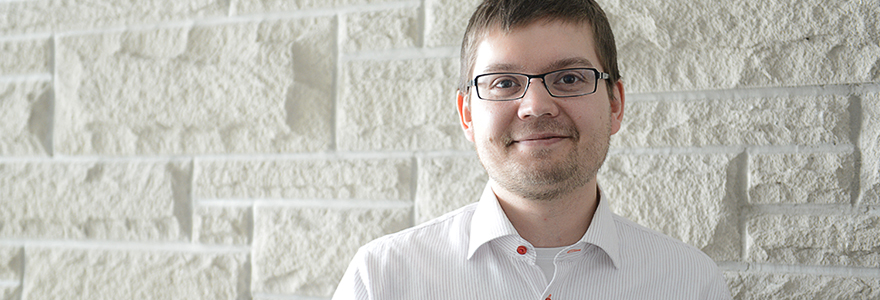Smart skin

Andrew Pruszynski’s research changes the way we see the role of peripheral nerves and could lead to significant improvements in treatment and rehabilitation
By Pat Morden, BA'77
Imagine a sophisticated robot capable of providing rehabilitative care to stroke survivors.
Sounds like a brilliant idea and it is. But as Andrew Pruszynski, PhD discovered, such a robot can only be programmed based on a clear understanding of how human limbs move.
Pruszynski actually built the robot while an undergraduate student in electrical engineering at Simon Fraser University. “We had no real idea how to use the technology, because no one understood the underlying biology,” Pruszynski said. “I could build it, but it wasn’t useful.”
Some people might have been discouraged and turned to other projects: Pruszynski decided to pursue a PhD in neuroscience. “It was a big change,” he admits. “I didn’t even take biology in Grade 11.”
He completed his doctorate, and his thesis won a Governor-General’s gold medal. It focused on how sensory inputs from muscles in the arm are used to adjust to unexpected perturbations. For example, if you reach out for a cup of coffee and something bumps your arm, you automatically correct and continue reaching for the cup. Except that it’s not automatic at all. “It turns out there are a lot of sophisticated computations that go into those corrections, and they use the same neural circuits that are used when you make a voluntary movement,” Pruszynski said. “There’s always been a division between voluntary movement and reflexes, but my work suggested that they are two parts of the same sensorimotor control process.”
He went on to complete postdoctoral research in Sweden, which is considered the birthplace of microneurography, a method used to visualize and record nerve impulses in the peripheral nerves of waking human subjects.
Microneurography involves inserting a fine tungsten needle electrode into the nerve and connecting it to an amplifier. Pruszynski used the technique to study the role of neurons in the skin when we’re manipulating an object. By moving the tip of the electrode, he was able to isolate the actions of specific neurons and then see where they were connected in the skin.
He discovered that neurons on the skin were able to signal, for example, the orientation of an edge touching its patch of skin. Previously it had been assumed that receptors on the skin were simply wires used to send information to the brain, where the complex computations were made to figure out what was happening. “We were able to show that the neurons in the skin already do a lot of computations that are useful in object manipulation tasks,” he said. “It turns out that they can produce information once thought to be a hallmark of cortical sophistication.” Future work will explore how the central nervous system deals with information provided by these neurons.
The findings are more than interesting: they have important implications for clinical care.
When someone experiences a peripheral nerve injury—perhaps as the result of a car or industrial accident—a surgeon stitches the nerve together and the nerve regrows. Generally, however, the patient doesn’t recover full function and can’t return to the same skilled job. Pruszynski thinks his research may help to explain why. “Our results suggest that we have to worry about much more than just the nerves regrowing,” he said. “If you want the person to recover fully, the nerves have to regrow in a very specific way that enables them to reproduce the computations they once did.”
In the short-term, this knowledge may be useful in determining which patients will recover best and which will need more intensive rehabilitation. In the longer-term, it may inform the development of better surgical strategies.
Pruszynski recently joined Schulich Medicine & Dentistry and is an Assistant Professor with Physiology and Pharmacology and a scientist at Robarts Research Institute.
Currently busy setting up his lab, Pruszynski’s next project will be to work with researchers at the Roth McFarlane Hand and Upper Limb Centre at St. Joseph’s Health Care London to explore more fully the potential clinical applications of his research.
He remains engaged in his research because he has found a sweet spot that brings together his training and interests. “It’s a good mix of the engineering and math side of my brain, and the neurophysiology side,” he said. “I get to work with computer scientists at one end of the spectrum, and surgeons at the other. All the different approaches are driving in parallel toward better outcomes for patients.”








